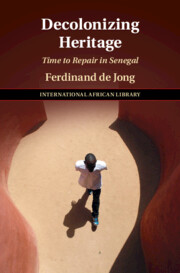52 results
Coda
-
- Book:
- Decolonizing Heritage
- Published online:
- 10 March 2022
- Print publication:
- 17 March 2022, pp 245-252
-
- Chapter
- Export citation
Acknowledgements
-
- Book:
- Decolonizing Heritage
- Published online:
- 10 March 2022
- Print publication:
- 17 March 2022, pp xi-xiv
-
- Chapter
- Export citation
2 - The Door of Return
-
- Book:
- Decolonizing Heritage
- Published online:
- 10 March 2022
- Print publication:
- 17 March 2022, pp 73-103
-
- Chapter
- Export citation
1 - History and Testimony at the House of Slaves
-
- Book:
- Decolonizing Heritage
- Published online:
- 10 March 2022
- Print publication:
- 17 March 2022, pp 39-72
-
- Chapter
- Export citation
5 - Recycling Recognition
-
- Book:
- Decolonizing Heritage
- Published online:
- 10 March 2022
- Print publication:
- 17 March 2022, pp 165-184
-
- Chapter
- Export citation
6 - Ruins of Utopia
-
- Book:
- Decolonizing Heritage
- Published online:
- 10 March 2022
- Print publication:
- 17 March 2022, pp 185-210
-
- Chapter
- Export citation
3 - Shining Lights and Their Shadows
-
- Book:
- Decolonizing Heritage
- Published online:
- 10 March 2022
- Print publication:
- 17 March 2022, pp 104-139
-
- Chapter
- Export citation
Copyright page
-
- Book:
- Decolonizing Heritage
- Published online:
- 10 March 2022
- Print publication:
- 17 March 2022, pp iv-iv
-
- Chapter
- Export citation
Prologue
-
- Book:
- Decolonizing Heritage
- Published online:
- 10 March 2022
- Print publication:
- 17 March 2022, pp 1-12
-
- Chapter
- Export citation
Bibliography
-
- Book:
- Decolonizing Heritage
- Published online:
- 10 March 2022
- Print publication:
- 17 March 2022, pp 253-280
-
- Chapter
- Export citation
Index
-
- Book:
- Decolonizing Heritage
- Published online:
- 10 March 2022
- Print publication:
- 17 March 2022, pp 281-292
-
- Chapter
- Export citation
Dedication
-
- Book:
- Decolonizing Heritage
- Published online:
- 10 March 2022
- Print publication:
- 17 March 2022, pp v-vi
-
- Chapter
- Export citation
7 - The Museum of Black Civilizations
-
- Book:
- Decolonizing Heritage
- Published online:
- 10 March 2022
- Print publication:
- 17 March 2022, pp 211-244
-
- Chapter
- Export citation
Figures
-
- Book:
- Decolonizing Heritage
- Published online:
- 10 March 2022
- Print publication:
- 17 March 2022, pp viii-x
-
- Chapter
- Export citation
Contents
-
- Book:
- Decolonizing Heritage
- Published online:
- 10 March 2022
- Print publication:
- 17 March 2022, pp vii-vii
-
- Chapter
- Export citation
Introduction
-
- Book:
- Decolonizing Heritage
- Published online:
- 10 March 2022
- Print publication:
- 17 March 2022, pp 13-38
-
- Chapter
- Export citation
4 - Prayer of Emergency
-
- Book:
- Decolonizing Heritage
- Published online:
- 10 March 2022
- Print publication:
- 17 March 2022, pp 140-164
-
- Chapter
- Export citation

Decolonizing Heritage
- Time to Repair in Senegal
-
- Published online:
- 10 March 2022
- Print publication:
- 17 March 2022
A FEMALE PROPHET IN WEST AFRICA - West Africa's Women of God: Alinesitoué and the Diola Prophetic Tradition. By Robert M. Baum. Bloomington, IN: Indiana University Press, 2016. Pp. x + 301. $80.00, hardback (ISBN 9780253017673); $32.00, paperback (ISBN 9780253017888).
-
- Journal:
- The Journal of African History / Volume 59 / Issue 2 / July 2018
- Published online by Cambridge University Press:
- 06 August 2018, pp. 339-340
- Print publication:
- July 2018
-
- Article
- Export citation



